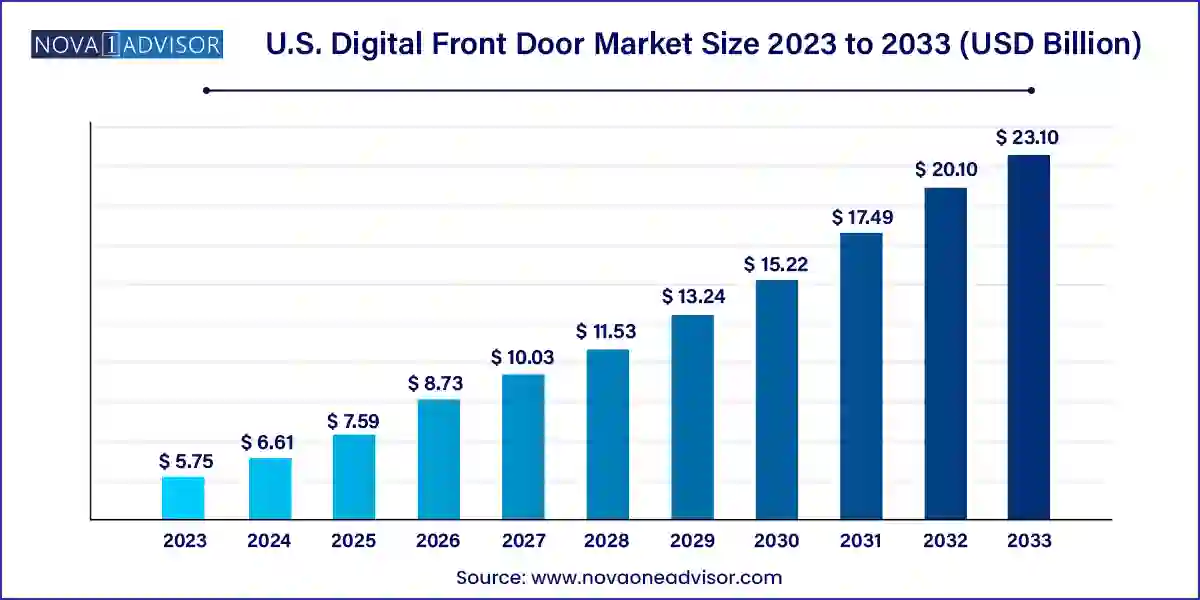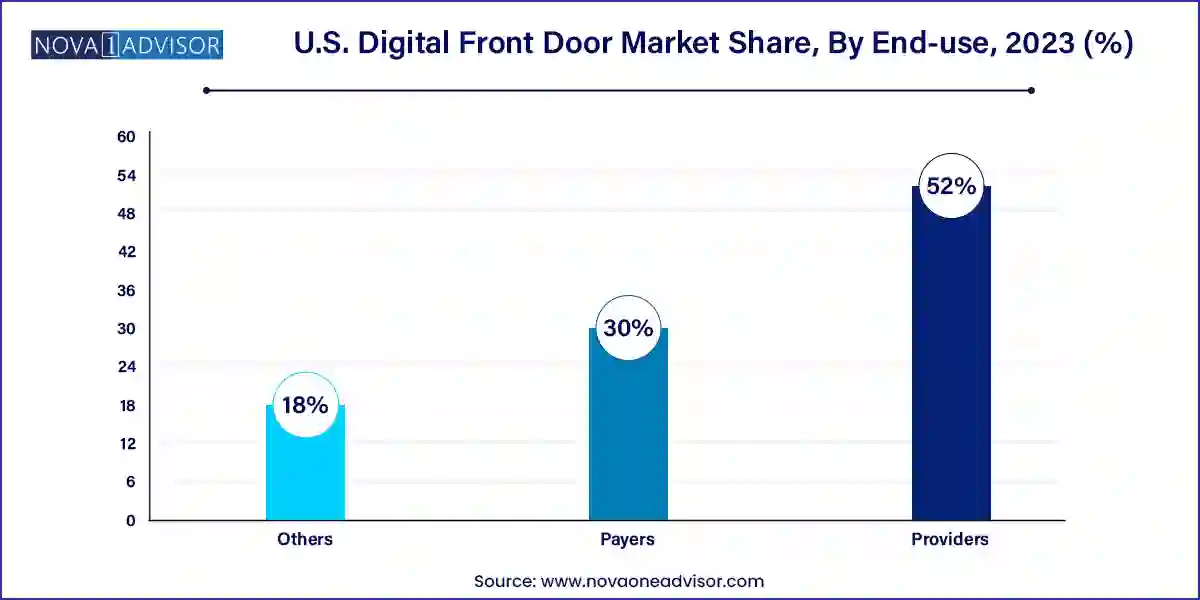U.S. Digital Front Door Market Size and Growth
The U.S. digital front door market size was exhibited at USD 5.75 billion in 2023 and is projected to hit around USD 23.10 billion by 2033, growing at a CAGR of 14.92% during the forecast period 2024 to 2033.

Key Takeaways:
- Based on interface, the mobile segment dominated the market for the digital front door and accounted for a revenue share of over 56% in 2023.
- In 2023, the providers segment reported the largest share of over 52.0% in the U.S. digital front door market.
- The others segment is expected to exhibit lucrative growth during the forecast period.
Report Scope of The U.S. Digital Front Door Market
| Report Coverage |
Details |
| Market Size in 2024 |
USD 6.61 Billion |
| Market Size by 2033 |
USD 23.10 Billion |
| Growth Rate From 2024 to 2033 |
CAGR of 14.92% |
| Base Year |
2023 |
| Forecast Period |
2024-2033 |
| Segments Covered |
Interface, End-use |
| Market Analysis (Terms Used) |
Value (US$ Million/Billion) or (Volume/Units) |
| Regional Scope |
U.S. |
| Key Companies Profiled |
Induction Healthcare Group PLC; Oracle (Cerner); Orion Health group of companies; DeliverHealth; mphrX; Persistent Systems; e-Zest Solutions; Seqster; HTC GLOBAL SERVICES; Silverline; GYANT |
Digital front doors enable healthcare professionals to engage with patients at all major touchpoints of their patient journeys. Consumers can access the health system, information, and guidance through Digital Front Door's effective, reliable, multi-channel access point. Enhancing customer experience, maximizing the value of existing patient engagement technologies, streamlining end-to-end customer journeys, and offering a secure center for all care interactions are some of the factors propelling market expansion.
Patients are seeking more control and options in the age of digital transformation, frequently through self-service, virtual, and digital channels. As a result, they can alter how services are accessible and interact with healthcare providers and organizations. The market for digital front doors is also characterized by the healthcare system's shifts, the user base's increasing needs, and significant changes in regulations and reimbursement.
During the COVID-19 pandemic, U.S. markets have undergone cyclical downturns and uncertainty observed in economic conditions. This uncertainty has been made worse by a variety of factors, including the constantly changing measures taken by governments, private companies, and other organizations to stop the spread of the virus and its variants, as well as inflation, supply chain problems, and geopolitical tensions such as the Russian invasion of Ukraine.
Thus, economic uncertainty and associated macroeconomic conditions made it extremely difficult for companies to accurately forecast and plan business activities. Besides, it could also cause the company’s clients to slow spending on their platform and product portfolio, which could delay and lengthen sales cycles. The recent resurgence of COVID-19 because of the emergence of new variants of the virus such as Delta also caused disruptions and severely impacted business, including, increasing the likelihood of clients not renewing their contracts or being unable to pay by the terms of their agreements; reducing the demand of the solutions offered on the platform due to restrictions on elective procedures and access to hospitals and other healthcare facilities, and among others.
During the COVID-19 pandemic, patient portals have assumed a greater significance as a tool for patient engagement than ever before, acting not only as the digital front door for healthcare organizations but also as the main method of communicating with doctors and nurses and even providing telehealth care. The pandemic, therefore, highlighted the significance of opening up the digital front door and adopting a more process-centric strategy in healthcare. Digital innovation is necessary for everything from delivering digital services to offering tailored patient care to reviving operational efficiencies.
As a result of the constant technological changes that influence how people connect through mobile devices like smartphones and tablets, new regulations came into place to safeguard these people and their rights as patients through the HIPAA privacy rule. Regarding the privacy and security of personal information, particularly protected health information (PHI), there are several federal and state rules and regulations in the United States. The establishment of administrative, physical, and technical protections is mandated by HIPAA to guarantee the confidentiality, integrity, and availability of PHI. HIPAA also specifies privacy and security requirements that restrict the use and disclosure of PHI. Some Final Rule provisions like CoP notifications have already come and gone and more regulations are coming down the pipeline.
With the U.S. physician shortage increasing, access will play a big role in the coming years as patients struggle to make appointments with their physicians. Virtual care is evolving rapidly and will encompass more than just primary care as patients need more tailored healthcare journeys. Thus, looking ahead, the personalization of health tech will further increase, and patients will demand even more convenient communication options and user-friendly healthcare technology as they seek to interact more directly and build deeper relationships with their providers.
Value-based care with digital options will continue to grow. More innovative models of healthcare that provide better and more cost-effective care will emerge in 2023. Payers and providers will continue the trend toward value-based care, focusing on helping patients manage chronic conditions and maintain better outcomes throughout their health journey at a lower cost.
U.S. Digital Front Door Market By Interface Insights
Based on interface, the mobile segment dominated the market for the digital front door and accounted for a revenue share of over 56% in 2023. The dominance is attributed to high internet usage, smartphones, and the adoption of these mobile apps. Moreover, the introduction of new platforms from market players is further influencing the market positively. In August 2023, CarePaths Inc. has launched CarePaths Connect, a new mobile application that adds to their mental health electronic health records platform with several features aimed at increasing patient participation and enhancing outcomes.
Furthermore, clinicians can customize their digital front door on CarePaths Connect, which is available for Android and iOS. This profile is seen by anybody using the CarePaths Connect app. The software allows users who are interested in treatment to search the CarePaths network for providers nearby, rapidly check their insurance coverage, and schedule available sessions. To facilitate communication with the therapist, the app also offers secure chat and teletherapy. This will lead to patients being more engaged and invested in the therapeutic process, which eventually improves clinical outcomes.
However, patients who are more likely to use technology are also more likely to be feeling "app fatigue," which is the urge to remove apps from a phone rather than add more apps that they might only use sometimes. As a result, the web interface will gain traction in the coming years.
U.S. Digital Front Door Market By End-use Insights
In 2023, the providers segment reported the largest share of over 52.0% in the U.S. digital front door market. The majority of patients are seen by providers, who are also the first point of call for consultations on a range of general and specialized health issues. Thus, these end users are the ones who use digital front doors the most widely. Gozio Health revealed in December 2023 that Children's Hospital & Medical Center has adopted its mobile platform as the cornerstone of a thorough digital front door strategy. A variety of consumer-facing digital aspects, such as internal and outdoor wayfinding, physician directories, appointment booking, and more, are now available to patients and families via the Children's GO app, all within a single, user-friendly interface.

The others segment is expected to exhibit lucrative growth during the forecast period. Pharmaceutical companies started to worry as the COVID-19 pandemic spread about keeping patients' access to the necessary medications. Their second problem was how to tell patients and doctors about newly available therapies and drugs after the continuity of care. Telehealth was understood as an option to provide many of the necessary bridges.
The expanding use of customer and patient interaction technologies that encourage widespread coverage and enable value-based care delivery is responsible for the expansion of the payer’s segment. The payers want to link patients at every stage of therapy and manage patient care to boost growth.
Some of the prominent players in the U.S. digital front door market include:
- Induction Healthcare Group PLC
- Oracle (Cerner)
- Orion Health group of companies
- DeliverHealth
- mphrX
- Persistent Systems
- e-Zest Solutions
- Seqster
- HTC GLOBAL SERVICES
- Silverline
- GYANT
Segments Covered in the Report
This report forecasts revenue growth at country levels and provides an analysis of the latest industry trends in each of the sub-segments from 2021 to 2033. For this study, Nova one advisor, Inc. has segmented the U.S. digital front door market
Interface
End-use


